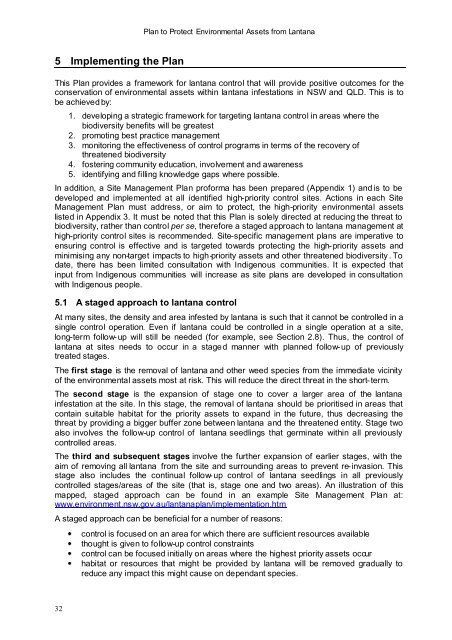Plan to Protect Environmental Assets from Lantana - Weeds Australia
Plan to Protect Environmental Assets from Lantana - Weeds Australia
Plan to Protect Environmental Assets from Lantana - Weeds Australia
You also want an ePaper? Increase the reach of your titles
YUMPU automatically turns print PDFs into web optimized ePapers that Google loves.
<strong>Plan</strong> <strong>to</strong> <strong>Protect</strong> <strong>Environmental</strong> <strong>Assets</strong> <strong>from</strong> <strong>Lantana</strong><br />
5 Implementing the <strong>Plan</strong><br />
This <strong>Plan</strong> provides a framework for lantana control that will provide positive outcomes for the<br />
conservation of environmental assets within lantana infestations in NSW and QLD. This is <strong>to</strong><br />
be achieved by:<br />
1. developing a strategic framework for targeting lantana control in areas where the<br />
biodiversity benefits will be greatest<br />
2. promoting best practice management<br />
3. moni<strong>to</strong>ring the effectiveness of control programs in terms of the recovery of<br />
threatened biodiversity<br />
4. fostering community education, involvement and awareness<br />
5. identifying and filling knowledge gaps where possible.<br />
In addition, a Site Management <strong>Plan</strong> proforma has been prepared (Appendix 1) and is <strong>to</strong> be<br />
developed and implemented at all identified high-priority control sites. Actions in each Site<br />
Management <strong>Plan</strong> must address, or aim <strong>to</strong> protect, the high-priority environmental assets<br />
listed in Appendix 3. It must be noted that this <strong>Plan</strong> is solely directed at reducing the threat <strong>to</strong><br />
biodiversity, rather than control per se, therefore a staged approach <strong>to</strong> lantana management at<br />
high-priority control sites is recommended. Site-specific management plans are imperative <strong>to</strong><br />
ensuring control is effective and is targeted <strong>to</strong>wards protecting the high-priority assets and<br />
minimising any non-target impacts <strong>to</strong> high-priority assets and other threatened biodiversity . To<br />
date, there has been limited consultation with Indigenous communities. It is expected that<br />
input <strong>from</strong> Indigenous communities will increase as site plans are developed in consultation<br />
with Indigenous people.<br />
5.1 A staged approach <strong>to</strong> lantana control<br />
At many sites, the density and area infested by lantana is such that it cannot be controlled in a<br />
single control operation. Even if lantana could be controlled in a single operation at a site,<br />
long-term follow-up will still be needed (for example, see Section 2.8). Thus, the control of<br />
lantana at sites needs <strong>to</strong> occur in a staged manner with planned follow-up of previously<br />
treated stages.<br />
The first stage is the removal of lantana and other weed species <strong>from</strong> the immediate vicinity<br />
of the environmental assets most at risk. This will reduce the direct threat in the short-term.<br />
The second stage is the expansion of stage one <strong>to</strong> cover a larger area of the lantana<br />
infestation at the site. In this stage, the removal of lantana should be prioritised in areas that<br />
contain suitable habitat for the priority assets <strong>to</strong> expand in the future, thus decreasing the<br />
threat by providing a bigger buffer zone between lantana and the threatened entity. Stage two<br />
also involves the follow-up control of lantana seedlings that germinate within all previously<br />
controlled areas.<br />
The third and subsequent stages involve the further expansion of earlier stages, with the<br />
aim of removing all lantana <strong>from</strong> the site and surrounding areas <strong>to</strong> prevent re-invasion. This<br />
stage also includes the continual follow-up control of lantana seedlings in all previously<br />
controlled stages/areas of the site (that is, stage one and two areas). An illustration of this<br />
mapped, staged approach can be found in an example Site Management <strong>Plan</strong> at:<br />
www.environment.nsw.gov.au/lantanaplan/implementation.htm<br />
A staged approach can be beneficial for a number of reasons:<br />
control is focused on an area for which there are sufficient resources available<br />
thought is given <strong>to</strong> follow-up control constraints<br />
control can be focused initially on areas where the highest priority assets occur<br />
habitat or resources that might be provided by lantana will be removed gradually <strong>to</strong><br />
reduce any impact this might cause on dependant species.<br />
32

















